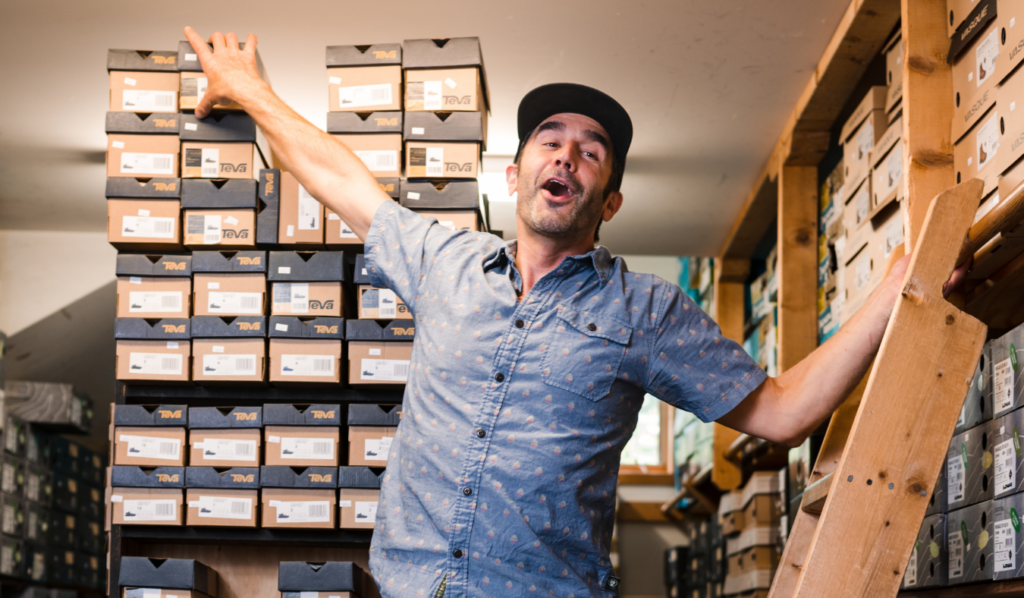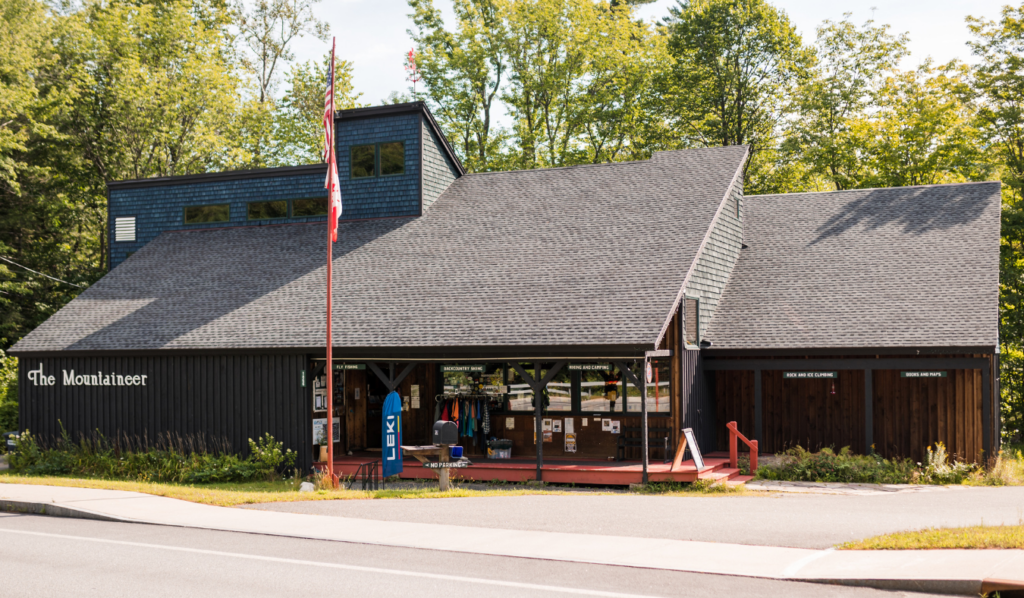Feature: The Mountaineer
By Olivia Dwyer

Charlie Wise snowshoes through dense balsam fir on the upper flank of 4,580-foot Wright Peak in New York’s Adirondack Mountains. Winter gusts reach 100 miles per hour here, adding windchill to below-zero temps. Wise clears treeline and steps into a face full of graupel. Zipped into a down-stuffed Mammut parka, he’s safe from the elements as he makes the summit and retreats to the trailhead.
This 2002 outing earned Wise a winter 46er, the moniker for New York’s 46 peaks over 4,000 feet. Wright sits in the Adirondack High Peaks, where a dense cluster of 46ers crown a rugged landscape that has drawn outdoor enthusiasts for the past 150 years. Since 1975, those hikers, climbers, and skiers have frequented The Mountaineer, an independent outdoor store renowned for knowledgeable staff and top-shelf gear. Wise visited days before his Wright hike in search of an insulated jacket, just one of many items he found at The Mountaineer before transitioning from customer to owner in 2018. That’s when he and his wife Nancy bought The Mountaineer from the founding family—and took on the task of guiding a legacy outdoor shop into a new era.
 The Adirondack Park is the size of Vermont with near the population density of North Dakota. Hikers navigate boot-sucking mud, steep trails that a cloudburst morphs into gushing streams, and use hands and feet on summit scrambles. “The Adirondacks chew gear up and spit it out,” says Matt Wiech, a mountain guide who joined The Mountaineer staff in 2020. The store perches on the AuSable River in Keene Valley, a town of 1,150 people deep in the High Peaks with hiking trails, alpine and cross-country backcountry ski tours, ice climbing, rock climbing, and fly fishing within a 10-minute drive of the shop. The front door is also 11 miles west of I-87, the gateway for many of the 60 million people living within a day’s drive.
The Adirondack Park is the size of Vermont with near the population density of North Dakota. Hikers navigate boot-sucking mud, steep trails that a cloudburst morphs into gushing streams, and use hands and feet on summit scrambles. “The Adirondacks chew gear up and spit it out,” says Matt Wiech, a mountain guide who joined The Mountaineer staff in 2020. The store perches on the AuSable River in Keene Valley, a town of 1,150 people deep in the High Peaks with hiking trails, alpine and cross-country backcountry ski tours, ice climbing, rock climbing, and fly fishing within a 10-minute drive of the shop. The front door is also 11 miles west of I-87, the gateway for many of the 60 million people living within a day’s drive.
Wise was nine years old on his first visit to The Mountaineer on his family’s trip to the 1980 Winter Olympics in nearby Lake Placid. The building’s key features remain: an angular roofline, 28-foot interior ceiling, and a central stairwell linking a ground floor and upstairs balcony area. Founder George McClelland and his four sons built it, finishing the interior walls with rough-cut pine. His son Vinny became general manager about a decade later.
The shop’s strategy has stayed constant: Hire staff with deep knowledge of mountain sports. Compensate these employees with a salary, benefits like a simple IRA and health insurance, and an annual bonus. Make them buyers in their area of expertise to ensure quality gear on every wall and rack. And, crucially, deliver exceptional service. Wiech, who’s guided trips from Denali to Aconcagua, splits his time between fitting hiking boots and managing brand partnerships. “Nearly every day, someone comes in with destroyed shoes to buy a better pair for their next trip,” he says. They soon join the ranks who buy new Scarpa trail runners or Lowa hiking boots on their annual Adirondack vacation.
Loyal customers span generations, relationships that often begin at the candy jars of 15-cent Swedish Fish, Fireballs, and Bazooka bubble gum situated at toddler height by the register. Another rite of passage is a $3.99 bandana printed with The Mountaineer’s logo. In the stairwell, a photo shows two customers holding a bandana’s corners for a photo at Antarctica’s Visson Massif. As McClelland says: “We wanted customers to be comfortable on Everest, bone fishing in the Caribbean, or with their kids on Owl’s Head” a nearby 0.9-mile hike. Wise followed that trajectory as he returned to The Mountaineer in the late 1990s with then-girlfriend Nancy, whose family visited each summer. As they lived on the West Coast and their parents in New York, the couple always returned to the Adirondacks and The Mountaineer.
That familiarized them with the shop’s community service too. Next year marks the 25th annual Mountainfest, a gathering of ice climbers and alpinists. For the inaugural fest, McClelland invited the town’s volunteer fire department to host a spaghetti dinner fundraiser. As a Patagonia dealer, The Mountaineer has secured grants for the Nature Conservancy to replace stream culverts and improve fish passage. Ski film screenings benefit Barkeater Trails Alliance, an area nonprofit that builds and maintains ski and mountain bike trails. A typical year sees $10,000 in cash and in-kind donations go to community organizations. And nearly every conversation on the shop floor includes the question, “Do you have a map?” With a room of printed maps covering the Northeast and guidebooks to match, they can make the answer a yes. The Mountaineer also rents bear canisters and snowshoes—required by New York for High Peaks outings—ice climbing equipment, and alpine touring gear backed by their status as a Dynafit Competence Center.
Shoppers are also likely to encounter New York State Forest Ranger Robbi Mecus in the shop. In the absence of state-run welcome centers, The Mountaineer is a key frontcountry contact point. Mecus answers questions and shares trip recommendations, and relies on the shop to keep her pack stocked. This July, when Mecus rescued a lost hiker from 5,344-foot Mount Marcy, it was The Mountaineer’s Honey Stinger pomegranate passionfruit chews that fueled the trek out. And when Mecus planned a spring expedition to Alaska’s Ruth Gorge, she turned to Wiech and his co-worker Matt Bealer, a climber and former backcountry steward, to find the right pack. “I took everything I’d have on the climb to the store, and we opened a bunch of packs and stuffed it in to narrow it down to the right one,” Mecus says. That process led her to the Mountain Hardware Scrambler 30L, which Brittany Purdy, inventory manager and women’s apparel buyer since 2013, ordered in Mecus’s size and preferred color. “They hire staff who are not just savvy about outdoor equipment,” Mecus says, “but have the ability to suss out an individual’s needs.”

In recent decades, Wise once again tapped into The Mountaineer’s expertise to progress as a backcountry skiing. Mike Kazmierczak, buyer of men’s apparel and ski hardwoods for a decade, helped Wise pair hardshells with midlayers made with active insulation for backcountry tours. That’s what Wise packed on a 2016 ski with McClelland, when a summit chat day raised the question about the shop’s future. With the next generation of McClellands dispersed across the U.S., Vinny said he was considering a buyer outside the family. “I knew retail was all new to Charlie, but I also knew he’s enthusiastic about learning,” McClelland says. “He’s a quick read and he works hard, and I knew he was the right guy for the job.”
The ski partners spent the next two years hammering out terms. McClelland provided seller financing to make the deal affordable for Wise, and signed on to work for a year alongside him for a smooth transition. “I think the lesson for sellers in the space is, give it time to find the right buyer and transition to a new owner,” Wise says. “I knew that after being a family-owned business for 40 years, it would be a bad plan to create any separation between community relationships and institutional knowledge.”
These ties proved crucial when COVID hit. Doors remained locked for 10 weeks, a crippling blow to a store where 85 percent of revenue is in-store sales, and forced Wise to furlough staff. McClelland adjusted payment terms to create a cushion against unknowns. As storefronts opened back up, employees returned and worked with Wise to prepare for an uncertain future. That included an accelerated update to The Mountaineer’s e-commerce functionality—online sales are up 150 percent since 2020—as well as upping orders for Appalachian Trail gear and expanding avalanche education as people opted for backcountry over resort crowds. “At first, COVID-19 brought a fairly predictable set of ripples,” Wise says, “but now it’s just chop.” In 2021, revenue was up 30 percent over an average year. Wise sees that as an outlier, and now says he tries to juggle what’s happening with overseas lockdowns, shipping delays, inflation, and markdowns on stockpiled inventory from big box stores with charting The Mountaineer’s next moves.
He’s also made changes to give staff updated tools to navigate those waters. While McClelland held onto old-fashioned registers, Wise implemented a computerized point of sale system to capture customer data and track inventory sell-through. The Mountaineer’s in-store book selections are now complemented by expanded inventory on bookshop.org, which gives independent booksellers an online platform. As Wise studied merchandising, he moved clearance sales from off-site to the upstairs loft. He used more rough-cut pine to construct shelves for unfurled sleeping bags and inflated sleeping pads. “Now people just pull them out to test on the floor,” Wise says.
Wise’s primary residence is still in southern Vermont as his wife continues her nursing career and the youngest of his three children completes high school. They’ve also become involved in the family business: Nancy developed the store’s COVID-19 protocols and daughter Hannah, a college student, is in her fourth summer on staff. “My biggest role is making sure staff has what they need to do what they do as buyers and customer service on the floor,” he says. Wise spends Tuesday to Friday each week in Keene Valley, splitting his store hours between a conference room crowded with 2023 ski boot boxes and the floor.
He also continues the tradition of prioritizing customer trust and loyalty. His own gear closet reminds him of what that looks like. That same 2002 Mammut jacket is still in rotation for winter chores like splitting wood and feeding chickens in brittle Northeast winters. “As long as we focus on making any outdoor experiences richer,” he says, “we’ll always be relevant.” And The Mountaineer’s legacy will live on.
Read The September 2022 Edition
Special thanks to our partners that make this possible:
